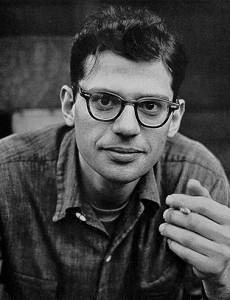Last Sunday night at Naropa, there was a celebration of Howl, in print now continuously for the past 50 years. There were excerpts from a documentary called Fried Shoes, Cooked Diamonds, Steven Taylor used Allen’s old harmonium to lead everyone in a song by William Blake & Taylor, Anne Waldman, Randy Roark & others got up & said or read things (I never noticed before just how much Anne stands with one foot raised off the ground as she reads, as if ready to spring into flight or dance). But the key to the evening was everyone – maybe 300 people! an SRO crowd in what I take to be Naropa’s largest auditorium – reading Howl aloud simultaneously. You should try this sometime.
One of things that happens is that the event itself takes over – there really are only one or two ways that that many souls can sound the same text at the same time & it sounds curiously similar to the pledge of allegiance, only this time to a very different nation, the real one. But underneath this overtone – it borders on the chants of Tibetan monks after awhile – you become aware of the lines in the text that fit comfortably with such a mode, both declamatory and almost hushed, and those lines that don’t. In Howl, there are many that don’t. Consider for example this six-line passage & how radically the four-part structure of that last line slows down the incessant forward motion:
who howled on their knees in the subway and were dragged off the roof waving genitals and manuscripts,
who let themselves be fucked in the ass by saintly motorcyclists, and screamed with joy,
who blew and were blown by those human seraphim, the sailors, caresses of Atlantic and
who balled in the morning in the evenings in rosegardens and the grass of public parks and cemeteries scattering their semen freely to whomever come who may,
who hiccuped endlessly trying to giggle but wound up with a sob behind a partition in a Turkish Bath when the blond & naked angel came to pierce them with a sword,
who lost their loveboys to the three old shrews of fate the one eyed shrew of the heterosexual dollar the one eyed shrew that winks out of the womb and the one eyed shrew that does nothing but sit on her ass and snip the intellectual golden threads of the craftsman's loom.
The key word in Howl, at least part I, is who. After the first three lines, in which the word doesn’t appear at all, it then is the first word¹ in 56 of the next 63 lines, 89 percent of the time. It occupies this position only twice in the final twelve lines², just enough to infer the cohesion of parallel syntax, even as the poem opens out to a wider range of syntactic forms as it winds to a stop.
Because Ginsberg uses anaphor and long lines, the poem encourages rapid pacing & few breaths at the end of line breaks. Yet these last lines are line brakes as well as breaks, as Ginsberg takes great care to let the text coast to a stop.
¹ There’s an argument to be made that the word in a line that receives the most emphasis is the one at the line’s end, followed by the first word, followed by the word that comes immediately before a caesura, followed in turn by the first word after that, etc.
² It is the second word in the 73rd line.






